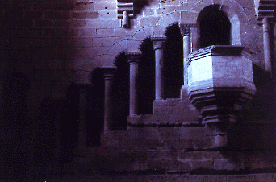ROUTE OF THE MONASTERIES IN ARAGON: THE MONASTERIES IN ZARAGOZA.
Nuestra Señora de Rueda. (Our Lady of Rueda).
As well as a monument worth visiting it is a nice place to enjoy a day out in the quiet and grassy banks of the river Ebro.
74 km. from Zaragoza, taking the road to Castellón. Once you’ve passed Quinto de Ebro, 20 km. ahead there is a secondary road to the left leading to Escatrón. On the other bank of the river Ebro, traditionally accessible by boat and, more recently, by a bridge, the uninhabited Cistercian monastery of Rueda (National Monument) stands, in a beautiful garden area.
It is the main monument of the low Aragonese area. The primitive 13th century lay-out and structure, which follows the Cistercian patterns, are extraordinarily well-preserved.

In 1835 the Desamortización (sale of Church lands and properties) left it in a state of total neglect. It has remained abandoned thereafter, apart from some restoring in the church. It was founded in 1184 by Alfonso II of Aragón and inhabited by Cistercian monks since 1202. Two building phases can be appreciated in the monastic ensemble: the primitive Protogothic buildings (13th century), and the rest of the constructions, from 1600.
Through a big arch we enter a big square, San Peter’s square. To the right, the abbey palace (1600), with long galleries of semicircular arches. To the left there is a building with sober balconies and Aragón’s coat of arms. The façade of the primitive monastery occupies the whole of the square’s far end. It is made of ashlar and it has an octogonal brick bell-tower with Mudejar tracery. To the left, the church, restored few years ago, has three naves with fan vaults and it is linked to a beautiful cloister From the 13th and 14th centuries. In one of the wings an octogonal pavilion was used as a lavabo. The refectory is a splendid lounge with pointed barrel vaulting and a majestic stair leading to the pulpit.
At the refectory’s sides we find the kitchen and a staircase leading to the upper floor, a Baroque addition. Then, the Sacristy, the Scriptorium and the Chapter house. In the upper floor, the bedroom, with wooden beams.
In the vegetable garden two of the primitive buildings have been conserved: the wine cellar and the remains of the rueda (wheel) that probably gave the monastery its name.
The Diputación General de Aragón has undertaken the difficult and expensive task of restoring the whole of the monastery’s buildings as well as the surroundings.

Route of the Monasteries in Aragón - HUESCA - TERUEL - ZARAGOZA
OTHERS MONASTERIES
Tourist Routes in Aragon
Ample your information on Aragon
If you want to extend your information on Aragon you can begin crossing another interesting route is the Mudejar, Patrimony of the Humanity, also you can extend your cultural knowledge on Aragon examining its municipal and institutional heraldry without forgetting, of course, some of its emblematics figures as Saint George Pattern of Aragon also book of Aragon.
Also Aragon enjoys a diverse and varied Nature where passing by plants, animals or landscapes we can arrive at a fantastic bestiario that lives in its monuments.
The information will not be complete without a stroll by its three provinces: Zaragoza, Teruel and Huesca and his shines, with shutdown in some of its spectacular landscapes like Ordesa, the Moncayo or by opposition the Ebro.
Also you can dedicarte to the intangible ones: from the legend compilation that also does to universal Aragon you can persecute the presence of the Santo Grial in Aragon.
Huesca |
Teruel |
Zaragoza |
Aragon |
Maps |
Fauna |
Flora |
Geology |
Fungi |
Tourism |
Mudejar |
Goya |
Alphabetical Index |
Thematic
Francisco Javier Mendivil Navarro
ROUTE OF THE MONASTERY IN ARAGON - ZARAGOZA - Huesca -Teruel. monumentally can be mentioned among the m ‡ s of SanPedro olden Siresa, with a possible western block-n postcarolingia tradition, and the San Juan de the Pe-a, with architectural remains ‡ moz-tronic Arabs, although in both cases the sets are completed ‡ estilorom essentially unique. In Arag-n ‡ mon acoustic architecture, with estructurade complex dependencies aclaustro organized around central expressive alcanzasu not complete until the introduction n-n of the Cistercians, with significant male monasteries Veruela, Stone and Wheel , ofemeninos, like Sigena founded in 1188. The mendicant orders accumulate-Franciscan monasteries and preachers in Aragon, delivering mind your arquitectura entre basi ‡ g-cal styles and Moorish. The Carthusians, at last but, not entered in Arag-n to the modern age.
Copyright 1996-2025 © All Rights Reserved Javier Mendivil Navarro, Aragon (Spain)
Explanations or to correct errors please press here
Legal Warning . This activity of the Asociacion Cultural Aragon Interactivo y Multimedia
All administration or public institution is made independently off.
As opposed to the threat of the hope of the water trasvase: CONGRATULATIONS.